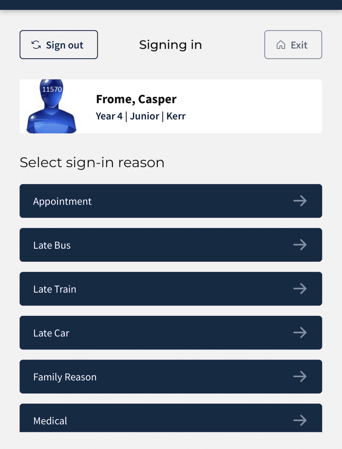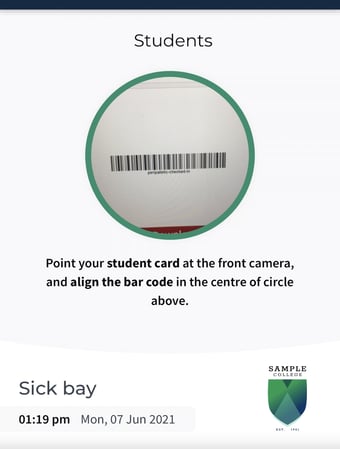Education Horizons is a leading Australian ed-tech provider, delivering smart, sophisticated software solutions that can support entire school communities; from students and carers through to teachers, administrators and decision makers.
The company's world-class solutions — Synergetic, SEQTA, Engage, AssetWhere and SchoolPRO — support more than 2,000 schools in over 60 countries. This includes more than 1.4 million student users and 195,000 teacher and administration staff users.
EHG engaged Propel Ventures as a Strategic Development Partner to accelerate the delivery of a new school kiosk solution. The kiosk project involved a rapid program of discovery, user research, design and delivery for a native iOS Arrival and Departure Terminal (ADT) kiosk application.
This solution was of high importance to one of EHG’s biggest clients, the Catholic Education Commission of Victoria (CECV), and their Integrated Catholic Online Network (ICON) project, involving more than 500 schools nationally.
The challenge
The CECV and their ICON project team are responsible for centralising the technology and learning systems for the 500 schools they represent nationally. As part of this process, ICON is constantly seeking to gain efficiencies — including streamlining the setup and maintenance of the many Kiosks on school campuses.
ICON was also aware of the need for a kiosk solution that could give teachers and administrators visibility of movements beyond the school reception area - tracking attendance at sick bay, co-curricular activities and visitor check-in. Modernising the kiosk interface to improve the customer experience was also a key priority and driver for moving to a tablet-based native iOS application.
EHG needed to deliver a more fully-featured kiosk solution within the space of five short months. A hard deadline at the end of the financial year meant there was no wiggle room, and would require a concerted effort from all involved. Committing to getting the project across the line in time drove the collective speed and urgency of the Kiosk project.
Our customer research found that the demand for new Kiosk features from ICON was also reflected more broadly in the education market. By accelerating the development of the Synergetic APIs required, this would enable EHG to roll out the extended Kiosk functionality to a wider group of new and existing customers.
Propel’s approach
Our approach involved a research phase to validate the user problem and scope, followed by a delivery phase.
Research Phase
Propel takes a human-centered approach to design, starting with customer insights to drive the vision of the solution design. We believe that discovery should be continuous and extend well beyond the first phase of the product delivery to ensure we continuously learn and adapt as we test the product with real-world customers — in this case, primary and secondary age students, teachers and school administrators.
The research phase consists of the following steps:
1. Establish Context of UseThe user interview component of our sessions explored EHG Design Lab School experiences - focussing on administrators and other high touch users of the system. Through these exploratory conversations, we developed a deeper understanding of the scenarios in which the Synergetic and other Kiosk solutions are used in the school ecosystem. 2. Conduct SME InterviewsWe conducted a deep dive with key stakeholders with subject expertise on Synergetic, Zunia and the existing Kiosk solutions in-market to understand the technology landscape and aggregated user needs. 3. Rapid PrototypingRapid ideation and low-fidelity sketches of the interaction designs for early scenarios were turned into test-ready clickable artefacts ready for user testing and validation. 4. Usability TestingRigorous hypothesis-driven usability testing sessions evaluated and validated the Kiosk wireframes and flows with primary and secondary students and teachers. In these sessions, users were asked to interact with a clickable prototype to complete key tasks. They were given the opportunity to provide feedback on desirable features, in turn lowering risks and speeding up the design process. 5. User Experience MetricsQuantitative measures of software on hedonic and pragmatic qualities (usability) were administered during usability testing sessions. We proposed the use of KANO in the next phase to benchmark the holistic user experience of the Kiosk against industry standards, as well as to measure every iteration on key variables. Namely, Perspicuity, Efficiency, Dependability, Attractiveness, Novelty and Stimulation. |
Throughout this engagement, Propel Ventures worked closely with EHG to implement Lean Development Principles and maintain open channels of communication and close feedback loops.
We took a customer-centric approach to delivering the iOS attendance Kiosk, drawing on user research findings to inform our mobile design system and developing a reusable component library for EHG’s ongoing use. We designed an intuitive and efficient user experience while allowing for flexibility and configurability in the system. A simplified device onboarding and configuration process was created by transferring data via QR codes.
Key tools, software and technologies used to deliver the Kiosks
- Human-centred design — customer research and discovery
- React Native & Typescript — build native iOS application
- SwaggerHub — define APIs between FE & BE teams
- Jira/ Confluence — Project management
- Miro — document discovery and delivery material
- Figma — construct mock designs and prototypes
Customer Outcomes
The product itself has been transformative in the way schools manage a more granular view of regular attendance patterns and non-standard check-ins as well as visitor check-in compliance. In many cases, students preferred to self-serve rather than wait to perform the same actions with a human, or felt more comfortable requesting services through a digital interface. Besides facilitating the complex interactions and managing the synchronisation of activities required by most education organisations, the Kiosk removes a lot of the friction and baggage of the legacy manual systems it supersedes.
"It’s remarkable how smoothly the project was run and delivered by Propel. I’m thrilled that the kiosk project achieved exactly what it promised, on time with excellent feedback from our customers.”
Rick Sharp, Chief Technology Officer at Education Horizons
All CECV requirements were satisfied within a shortened four-month timeframe, resolving the necessary pain points for school administrators. The project was a big success, strengthening EHG’s market position with its intended client. The reusable asset production process means that EHG can swiftly roll out a proven successful attendance Kiosk to new and existing customers.
“Propel’s guidance and technical knowhow has been a determining factor in the success of our Kiosk project. The solution adds value for our clients and enhances our product line going forward.”
Anneliese Urquhart, Chief Product Officer at Education Horizons
The solution also now contributes to open-source software with enhanced formatted printing capabilities for the Epson Thermal printer. This meant we could achieve higher fidelity printed collateral to enhance the kiosk experience, while building the reputation of EHG as a technical leader in this sector.
“Propel’s professional, collaborative approach has helped Education Horizons deliver a solution that did exactly
what our client needed it to. We couldn’t be happier with the result.”David Weickhardt, Chief Executive Officer at Education Horizons
Propel’s careful attention to detail in research and scoping meant that we were able to reduce the risk around faulty products, ineffective UX or general market-fit. By following The Propel Way™, we strive to make sure that the minimum viable product comes out already matured and built to purpose, eliminating double handling and delays in further refinement.



